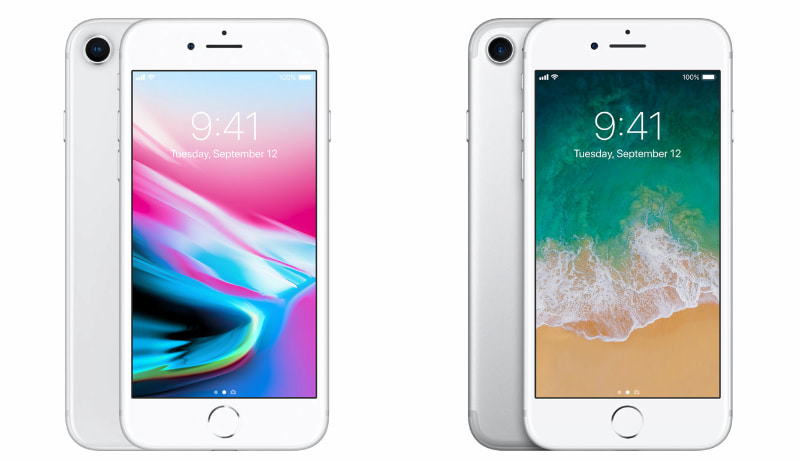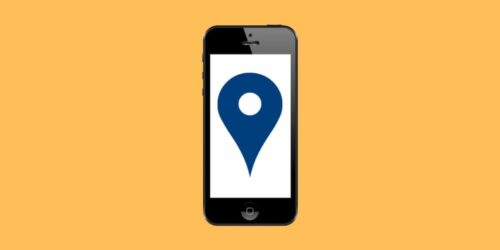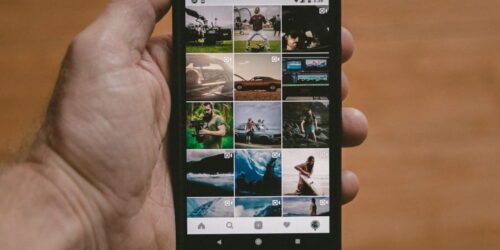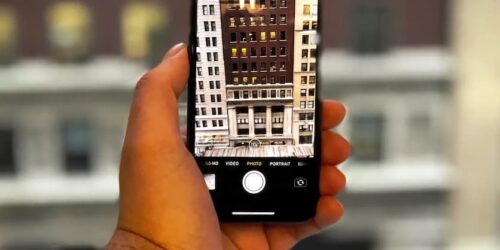iPhone 7 vs iPhone 8 In 2022: What’s The Differences & How To Choose
Not what you might expect is the iPhone 8. Unlike recent years Apple did not follow the iPhone 7 with an ‘iPhone 7S’ so instead we have the iPhone 8 and iPhone 8 Additionally, there is the completely new iPhone X, which has been completely redesigned and is astronomically expensive.
A quick look at iPhone 7 vs iPhone 8: Still quick, gorgeous, and enjoyable to use, the iPhone 7 is. Opting for the iPhone 8 grants you access to an even faster A11 processor, improved True Tone display, better video support options, and improved Bluetooth. Most appealingly, wireless charging. Depending on your priorities, you may decide that these improvements are worth the extra £150/$150 (with admittedly twice the storage at each tier).
However, in our opinion, the iPhone 8’s upgrades were covered up by the glitz and glamour of the iPhone X, which in any other year would have seemed like a worthwhile advancement. Of course, there are even newer options now that the iPhone 8 and X have been available for a full year, and those with high expectations and budgets may want to take the iPhone XS into consideration as well.
Please continue reading so I can show you the post’s more detailed information.
Table of Contents
Design: iPhone 7 vs iPhone 8
Although the iPhone X is a fairly significant redesign, the iPhone 8 generally shares the same chassis as the iPhone 7 and the iPhone 6s and 6 before it. It’s a four-year-old design that is a classic but is beginning to look dated.
The most significant change may have been made this year: the iPhone 8 has a glass front and back, making it compatible with wireless charging accessories. Nevertheless, some changes have been made over the years. In comparison to aluminum, it also gives the smartphone a more “premium” appearance, though there have been some concerns raised about its durability. (Although we haven’t seen any more scratches than usual, your experience may differ.)
Apple claims the glass is custom-made with a “50 percent deeper strengthening layer”, and points to the introduction of a steel substructure alongside the 7000 Aluminum series band to add additional frame reinforcement. However, we would advise using a case as the new handsets appear to be subjectively undeniably a little less durable than their predecessors.
In addition to the potential for breakage, this modification makes the iPhone 8 slightly larger than the iPhone 7 (138.4mm x 67.3mm x 7.3mm vs. 138.3mm x 67.1mm x 7.1mm) and 10g heavier (148g).
Both the iPhone 7 and the iPhone 8 lack a headphone jack. Additionally, they both have customisable solid-state home buttons that buzz to simulate a click rather than actually clicking downward, which should make them theoretically less prone to malfunction than older-style home buttons.
It is unquestionably true that the new buttons have not caused any issues for us. But it should be noted that the epidemic of defective Home buttons that we observed around the time of the iPhone 5 had already been largely resolved before the advent of the non-clicking buttons.
Colour Finishes: iPhone 7 vs iPhone 8
The iPhone 7 is a better choice if you want more color options. Silver, gold, rose gold, black, and jet black are the five colors available for that phone. (Prior to being discontinued, it was also available in Product Red.)
The iPhone 8 is only offered in (apparently slightly pinker) gold, silver, and space grey; as of April 2018, a Product Red variant has been brought back.
Wireless Charging: iPhone 7 vs iPhone 8
As was already mentioned, the iPhone 8 (as well as all other iPhones from the 2017 model year) have glass backs and can therefore use wireless charging accessories.
The iPhone 8’s wireless charging capabilities at launch were limited to 5W, which meant it could not charge the device any faster than the wired charger that came with it. In fact, we noticed that it was very slightly slower, most likely due to inefficiencies with the third-party wireless charging pad we were using. The cap was increased to a faster 7.5W with the iOS 11.2 update, though, when using compatible accessories.
Any accessories that have been approved to work with the Qi standard should function with the iPhone 8.
Battery: iPhone 7 vs iPhone 8
The battery life claims for the 7 and 8 are identical: up to 40 hours of wireless audio playback, up to 12 hours of internet use, and up to 14 hours of talk time. Our arbitrary tests bear this out. The iPhone 8 won’t last for days on a single charge, but we’ve discovered that it can last the entire day with typical use.
In contrast to the iPhone 7, the iPhone 8 offers fast charging—Apple claims it can charge up to 50% in 30 minutes—and compatibility with Qi-standard wireless chargers.
Screen Size And Home Button: iPhone 7 vs iPhone 8
There aren’t many physical differences between the iPhone 7 and iPhone 8 when you compare the two models side by side. The front-facing camera position, 4.7-inch screen size, and home buttons are all the same on both iPhones. Everything on the front is virtually the same — that is, until you flip them over…
Build Quality (Metal Vs Glass): iPhone 7 vs iPhone 8
When upgrading from an iPhone 7 to an iPhone 8, the newer all-glass back represents the most significant design change. After the iPhone 8, this became the norm, and it’s not just for aesthetic purposes. Wireless charging is possible thanks to the glass back, but as you might have guessed, fragility is a trade-off. Apple says the iPhone 8’s back is some type of reinforced glass that’s “the most durable glass ever made in a smartphone.”
No matter what Apple says, the iPhone 8 is undeniably more delicate than the previous all-metal iPhone 7 design, which makes it more prone to expensive repairs. You understand that because glass and hard surfaces have never made the best of friends.
Although wireless charging can be convenient, it may not be a “must-have” feature for users already accustomed to traditional (and quicker) wired charging. You cannot pick up a phone that is charging wirelessly and use it while it is doing so because the phone must lie flat on a charging pad in order to maintain its charge. All-in-all, it’s not really that convenient now, is it? See more about iPhone 13 Vs. iPhone 11
Size: iPhone 7 vs iPhone 8
The iPhone 8’s exterior resembles the iPhone 7 almost exactly aside from that. The location of the camera, the home button’s fingerprint sensor, and the size of the screen are all constant. Actual dimensions are extremely close, with the iPhone 8 size being just ever so slightly larger than the iPhone 7 size, and a little heavier thanks to the glass back. It’s virtually indistinguishable to the human eye, but if you’re looking to compare the exact size of the iPhone 7 and iPhone 8, here are the dimensions of each:
- iPhone 7 size: 138.3 x 67.1 x 7.1 mm, 138g
- iPhone 8 size: 138.4 x 67.3 x 7.3 mm, 148g

A10 Fusion Vs A11 Bionic Processor: iPhone 7 vs iPhone 8
The iPhone 8 is powered by Apple’s lightning-fast A11 Bionic chip. In comparison to the A10 Fusion chip in the iPhone 7, Apple claims that the iPhone 8’s two high-performance cores are about 25% faster, and the A11’s GPU is 30% faster. Any improvement is certainly appreciated, but if you don’t frequently play iPhone games that require 3D graphics, it might not be worthwhile to spend more money just to get the A11 chipset.
When using the iPhone 8’s A11 chip and the iPhone 7’s older A10 chip side by side in everyday situations, you probably won’t notice many (if any) performance differences. This is my own personal experience as someone who recently upgraded from an iPhone 7 to an iPhone X, which has the more modern A11 chip. Performance on the device while using social media and other apps, in my opinion, was almost identical. Most casual users probably won’t notice any significant differences as a result of this alleged speed increase (if there was any).
Camera: iPhone 7 vs iPhone 8
On paper, it might not seem like much has changed from the iPhone 7 with regard to this feature, like many other features of the iPhone 8.
Both of the cameras on the iPhone 8’s front are the same as those on the iPhone 7: a 12 megapixel wide-angle camera with an f/1.8 aperture and optical image stabilization, and a 7 megapixel camera with an f/2.2 aperture. It also draws attention to the fact that the iPhone 8 is the only new iPhone without dual rear cameras.
The A11 Bionic, however, improves the atmosphere. Due to the iPhone 8’s built-in and Apple-designed Image Signal Processor (ISP), Apple promises significant improvements in both photography and video. This should improve low-light auto focus, reduce noise, and improve pixel processing. The iPhone 7’s weakness was its latter two features.
It’s not true if it seems too good to be true. With the Pixel and Pixel XL, which both have camera optics that are inferior to most of their competitors’, Google won the camera crown last year. They did so thanks to their industry-leading image processing. We may therefore have a new class leader on our hands if Apple can match the brains Google displayed with better hardware.
Storage: iPhone 7 vs iPhone 8
Apple sold the iPhone 8 and the iPhone 7 back in 2018. The iPhone 7 was available with 32GB, 128GB, and 256GB of storage space, while the iPhone 8 had 64GB, 128GB, and 256GB of storage space.
Specs: iPhone 7 vs iPhone 8
| iPhone 7 | iPhone 8 | |
| Display | 4.7-inch LCD (1334×750) | 4.7-inch LCD (1334×750) |
| Rear camera | 12MP, f/1.8, OIS | 12MP, f/1.8, OIS (Slow Sync) |
| Processor | A10 | A11 |
| RAM | 2GB | 2GB |
| Storage | 32/128/256GB (discontinued) | 64/256GB |
| Battery | 1,960mAh | 1,821mAh w/ fast charge |
| Security | Touch ID fingerprint sensor | Touch ID fingerprint sensor |
| Water resistance | IP67 | IP67 |
| Size (dimensions) | 138.3×67.1×7.1mm | 138.4×67.3×7.3mm |
| Weight | 138g | 148g |
The iPhone 8 feels more like an iPhone 7S than a true bona fide sequel because overall, the iPhone 7 and iPhone 8 have more things in common than they do actual differences. Each device has an IP67 rating for water resistance, making the iPhone 7 a more affordable choice for taking pictures by the pool.
The resolution, size, and technology of the displays on both phones are the same. The addition of Apple’s True Tone technology, which blocks blue light and improves the viewing experience when using your phone in warm lighting at night, is the only advantage the iPhone 8 display has over the iPhone.
Price: iPhone 7 vs iPhone 8
The price is the main distinction between the iPhone 7 and iPhone 8. Now that you have a better idea of how each device compares to one another, you’re in a much better position to decide whether those “upgrades” are worth the hit to your wallet.
| Used iPhone 7 prices | Unlocked | Verizon | AT&T | T-Mobile |
| iPhone 7 (32GB) | $93+ | $80+ | $73+ | $85+ |
| iPhone 7 (128GB) | $93+ | $93+ | $78+ | $93+ |
| iPhone 7 (256GB) | $114+ | $140+ | $114+ | $93+ |
Used iPhone 7 prices as of October 4, 2022
| Used iPhone 8 prices | Unlocked | Verizon | AT&T | T-Mobile |
| iPhone 8 (64GB) | $115+ | $123+ | $103+ | $115+ |
| iPhone 8 (128GB) | $181+ | $185+ | $165+ | $134+ |
| iPhone 8 (256GB) | $145+ | $145+ | $145+ | $145+ |
Which Is The Best Option For You?
The redesign of the iPhone 8 immediately distinguished it from the models that came before it. Apple claims that the strongest glass they have ever used has replaced the aluminum casing. This glass gives the phone more than just durability and aesthetic appeal; it also enables wireless charging, which allows the phone to regain 50% of its charge in just 30 minutes.
And the iPhone 8 is more complex than first appears. Its new six-core A11 chip is a significant advancement over the A10, providing you with a quicker, more streamlined performance.
Even so, there are a lot of positive things about the iPhone 7. It’s still a top-of-the-line phone, and some people will undoubtedly continue to prefer the more traditional iPhone appearance. Both phones have excellent cameras and are water and dust resistant, but if you want a more advanced phone, the iPhone 8 is the one for you.
Conclusion
Since the iPhone 8 will likely appear to most iPhone owners to be more of the same, it makes sense that the iPhone X will garner the most attention for its radical design changes.
This makes sense given that the iPhone 8 is a bit of a contradiction. In terms of performance and possibly the camera, it is not a significant improvement over the iPhone 7, and Apple has taken away the fun of its fast charging. The iPhone 8 is not worth the upgrade if you currently own an iPhone 7.
However, the iPhone 8 may also be a good deal. When the display and Face ID are removed, the iPhone 8 becomes essentially an iPhone X (which won’t be available for months) for $300 less while still retaining Touch ID.
Owners of iPhone 7s should not be impressed as a result, but for everyone else, the iPhone 8 might be the best boring phone available…
I appreciate you reading.





